The Breguet family revolutionized watchmaking in the 19th century and aviation in the 20th. The modern Type XX collection is the culmination of its multi-generational savoir faire in both fields. We explore the history of this storied watch model in this feature from the WatchTime archives.

Montres Breguet, founded by legendary Parisian horologist Abraham-Louis Breguet in 1775 and renowned as the watchmaker to royalty like Napoleon Bonaparte and Marie Antoinette, is not a watch brand commonly associated with traditional “tool watches.” Take a closer look at the venerable maison’s history, however, and its contributions to the more practical side of timekeeping come into focus. (Of course, even Breguet’s most influential invention, the tourbillon, now regarded as an attractive but redundant feature in a wristwatch, was itself a practical invention in the beginning.) Its nautically influenced Marine series evolved from the marine chronometers that Abraham-Louis Breguet produced as official watchmaker to the French Royal Navy in the 1800s, for example. And the other Breguet watch collection that regularly marries utilitarian roots with luxurious contemporary details, the aviation-centric Type XX, traces its illustrious history to the early 20th century and the first Breguet scion to branch out from horology into the nascent field of manned flight.


That history begins with Louis-Charles Breguet (1880-1955), great-great-grandson of Abraham-Louis and one of early aviation’s major pioneers. Educated in engineering at France’s École supériuere d’électricité, Louis-Charles embarked upon a different professional path than that of his watchmaking ancestors, fascinated by the new science of aviation that had begun to gather steam in the early 20th century. In 1905, Louis-Charles teamed with his brother Jacques to invent an early gyroplane, a forerunner of the modern helicopter, which in 1907 became the first piloted aircraft to make a vertical-ascent flight. This invention heralded a number of breakthroughs in years to come. Louis-Charles built and flew his first fixed-wing aircraft, called the Breguet Type I, in 1909 at the world’s first international event devoted to showcasing heavier-than-air flying machines, the Grande Semaine d’Aviation de la Champagne. Just a few years later, in 1911, he founded the Societé des Ateliers d’Aviation Louis Breguet — later shortened to Breguet Aviation— whose earnest mission was the manufacturing of aircraft for the increasingly mobile world of the 20th century.

World War I, which began in 1914, was the first military conflict during which airplanes would play a pivotal, tactical role, and Breguet Aviation swiftly became one of the most important contributors to the war effort for Louis-Charles’ native France. The company manufactured aircraft for both reconnaissance and bombing missions, including the famous Breguet 14 biplane, which was used for both; it was also notable as the first mass-produced aircraft to use large amounts of metal, rather than wood, in its airframe, rendering it lighter and more maneuverable in aerial combat. The Breguet 14 was such a success that it was exported to squadrons of other Allied nations, including the United States, and paved the way for other significant models like the Breguet 19, another light-bodied bomber, and the 763 Deux-Points, an early double-decker transport plane. After the war, demilitarized Breguet 14 planes were pressed into service to fly airmail and freight by another firm founded by Louis-Charles Breguet, Compagnies des messageries aériennes, an early commercial airline that merged with four others in 1933 to form today’s Air France.

After World War I ended, Breguet Aviation shifted its focus from military mass production to pushing boundaries in aerial technology, with planes that set records such as the first non-stop crossing of the South Atlantic in 1927, and an air speed record of 67 mph in 1935. In addition to continuing to construct what were by then regarded as conventional aircraft — monoplanes and biplanes — Louis-Charles also returned to his experiments with gyroplanes, with historic results: the Breguet-Dorand Gyroplane Laboratoire, completed in 1933 and test-flown to set new records in its category in 1935-36, is regarded as the first modern helicopter. Such inventive endeavors were once again put on hold When World War II broke out in 1939, and Breguet Aviation returned to the production of military planes.

While Louis-Charles Breguet was finding success in his aeronautical endeavors, his family’s watchmaking firm, still based in Paris and known as Breguet et Fils, was undergoing some transitions in the early 20th century. Louis Antoine Breguet, Abraham-Louis’s great grandson, whose two children declined to enter the family business after his death at age 31, sold the company to Edward Brown, a British watchmaker who had served as Breguet’s factory manager. Brown’s son Henry took the reins of the company, renamed Maison Breguet, in 1900 after his father’s death and his brother Edward’s retirement.
Henry and his son George, who took over the company’s management in 1927, maintained ties with the Breguet family, including with Louis-Charles. Throughout both World Wars, the Breguet watchmaking firm provided both wristwatches and dashboard clocks for Breguet Aviation. The manufacture produced its first wristwatches for aviators in 1918 and also began to provide chronograph-equipped clocks. These devices, which were used for calculating distance, fuel consumption and navigational details, and meeting other logistical challenges posed by aviation, were installed in the cockpit instrument panels of the Breguet warplanes employed by the French Naval Air Arm, or Aéronavale, which was established by France’s Ministry of War in 1910. Breguet continued to make pilots’ watches for French military units throughout the 1930s, including its first wrist-borne chronographs in 1935.
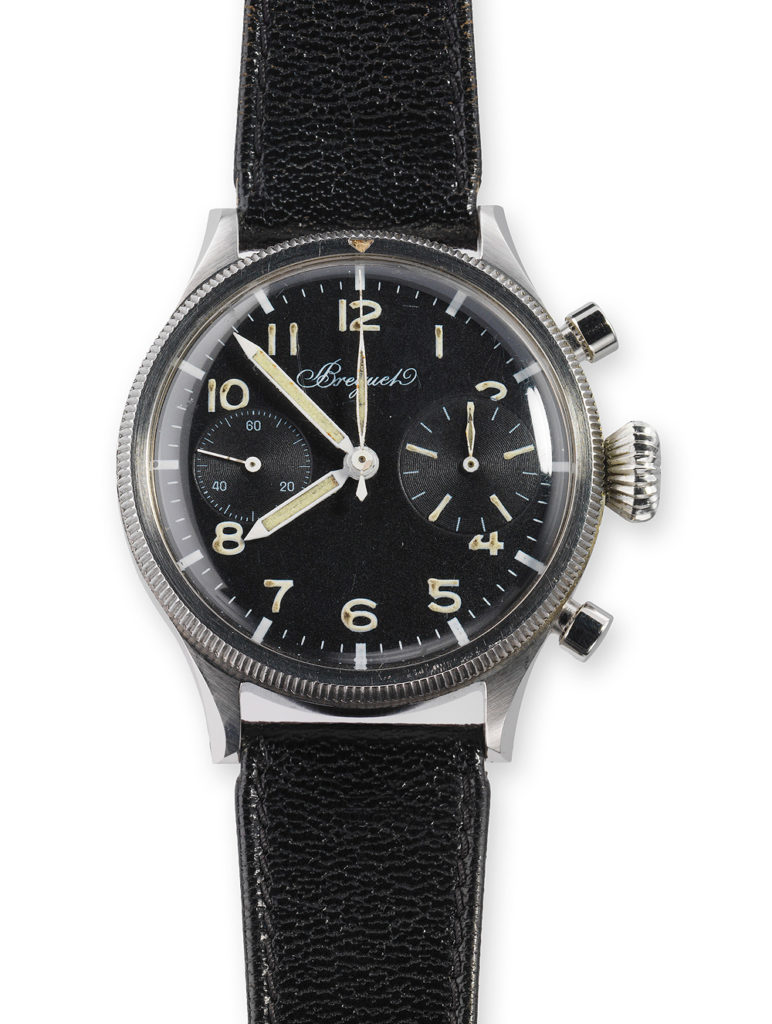
Fast-forward to the postwar 1950s. The watchmaking manufacture founded by Louis-Charles Breguet’s family was still in the hands of his friends, Henry and George Brown. In 1954, Breguet became the official supplier to the Aéronavale, which was seeking a watch for its military pilots, producing in that same year the first Breguet Type 20 wristwatch, a model only available to military personnel. Its design, based on that of the 1930s models, set the stage for the many evolutions to follow: 38-mm steel case, black bicompax dial with luminous hands, and perhaps most significantly, one of the first flyback chronograph functions offered in a wristwatch. In 1958, the Aéron- avale approached Breguet about a pilot-friendly upgrade: replacing the 30-minute chronograph counter with a 15-minute counter, the latter representing the required time to check an aircraft before flight. The first of these watches, inscribed with “Marine Nationale Aeronautique Navale” on their casebacks and produced in a series of 500 pieces, were issued in 1960.
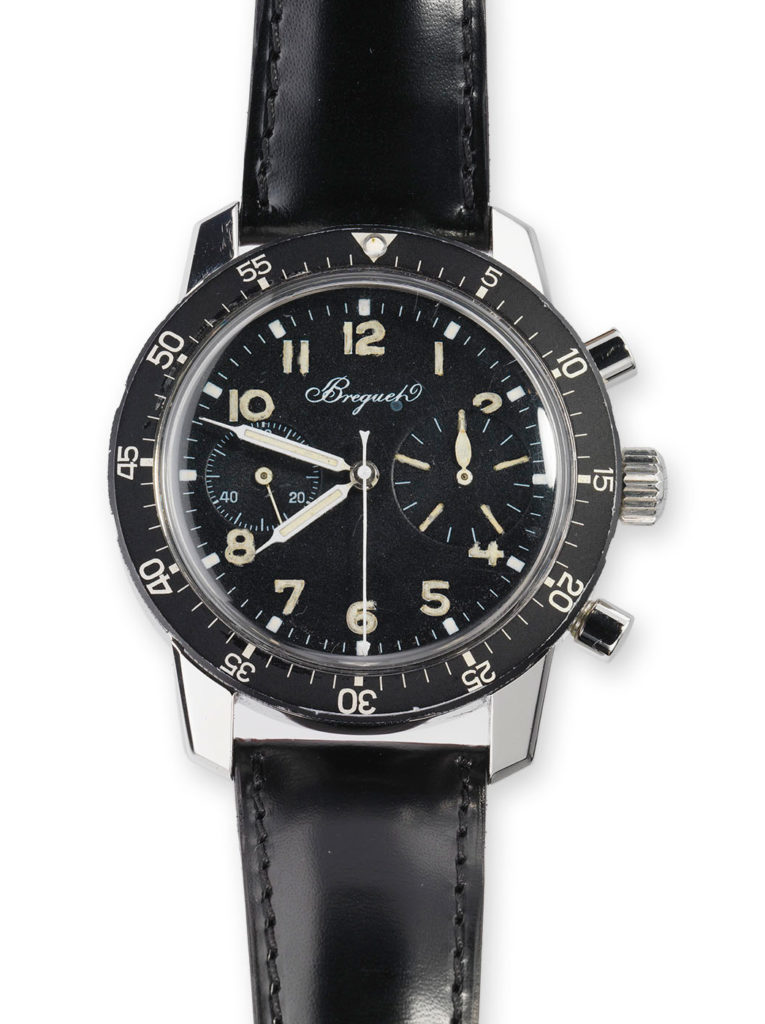
Breguet began producing a commercial version of the Type 20 shortly thereafter; this second-generation model, sold in the early 1960s, inaugurated the “Type XX” designation, replacing the Arabic numeral with a Roman one. It also sported some material and aesthetic updates: a thicker bezel made of black Bakelite, larger lugs, and a new tricompax dial layout. Like its military predecessor, it was powered by a flyback-chronograph-equipped Valjoux movement.
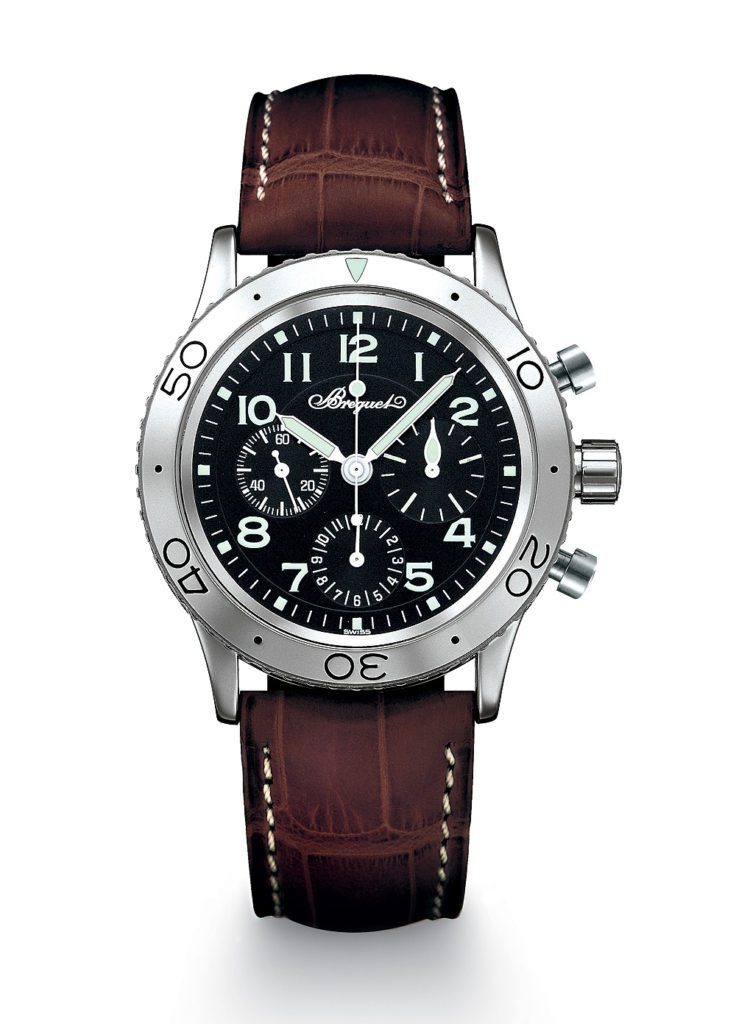
The third generation of the Type XX appeared in 1995, several decades after the second was discontinued; like so many of its mechanical brethren, the Breguet Type XX was buried beneath the crashing waves of the 1970s-1980s Quartz Crisis and dormant until the luxury mechanical watch began re-emerging in the ’90s. During this tumultuous era, the Breguet firm had once again changed hands. The Brown family, which had run the storied maison for 100 years, longer even than the founding Breguet family, sold it to Parisian jeweler Chaumet in 1970, which moved its operations from Paris to Switzerland’s Vallée de Joux in 1976 before selling it again to the Bahrain- based Investcorp in 1987.
The Type XX Aeronavale model introduced several changes — some subtle, like the slightly larger 39-mm case, others significant, like the coin-edge fluting added to the sides that has now become a signature motif of the series. The other major change was this model’s use of a new, self-winding movement, the Breguet 582, based on the Lemania 1350 and incorporating an in-house module for the flyback functionality. Following up the Aeronavale model in 1998 was the Type XX Transatlantique, which added a date display to the subdial at 6 o’clock and replaced the Aeronavale bezel’s polished finish with a more utilitarian circular brushing. With the Transatlantique, Montres Breguet also acknowledged the aviation history that it shared with Breguet Aviation, packaging the timepiece in a special presentation box that celebrated the non-stop flight from New York to Paris by a Breguet 19 plane in 1930.


With the new millennium came new ownership — by the Swatch Group, which acquired Breguet in 1999 as the timepiece conglomerate’s crown jewel — and also another iteration of the Type XX, which finally evolved substantially enough from its ancestors to earn a new numeral. The Breguet Type XXI debuted in 2001, in a new case made of titanium and upsized to a more contemporary 42 mm in diameter. Its flyback chronograph, in this model driven by the automatic Breguet Caliber 584Q, now used center-mounted hands to tally both the elapsed hours and minutes, and a day-night indicator to accompany the 12-hour totalizer, small seconds display, and date in the three-register dial layout.

Breguet flexed its technical muscles with the introduction in 2010 of the sixth-generation Type XXII, offered first in steel and later in rose gold. Its manufacture movement features an escapement and flat balance spring made of lightweight, antimagnetic silicon, enabling the watch’s super-fast frequency of 72,000 vibrations per hour, or 10 Hertz. The result is a movement with exceptional regulating power: the chronograph seconds hand makes a complete rotation in 30 seconds rather than the traditional 60 seconds, making the chronograph’s start function and readout twice as precise. The use of silicon — which Breguet, as well as some of its sister brands within the Swatch Group, helped pioneer — makes the mobile components more lightweight and free of the lubrication problems encountered by other high-frequency balances. Breguet also ensured that reading these swifter stopwatch tallies on the dial would be easy and intuitive: the minutes graduations on the flange are alternating red and white dashes, and the numbered seconds graduations use the same red-and-white combo; this enables the user to discern whether the chronograph counter is in the first (red sectors) or second (white sectors) stage of its 30-second revolution. The Type XXII also upped the ante in complexity, host-ing not only the flyback chronograph, date and day-night indicator but also a dual time-zone display that can be operated easily via the two-position crown.
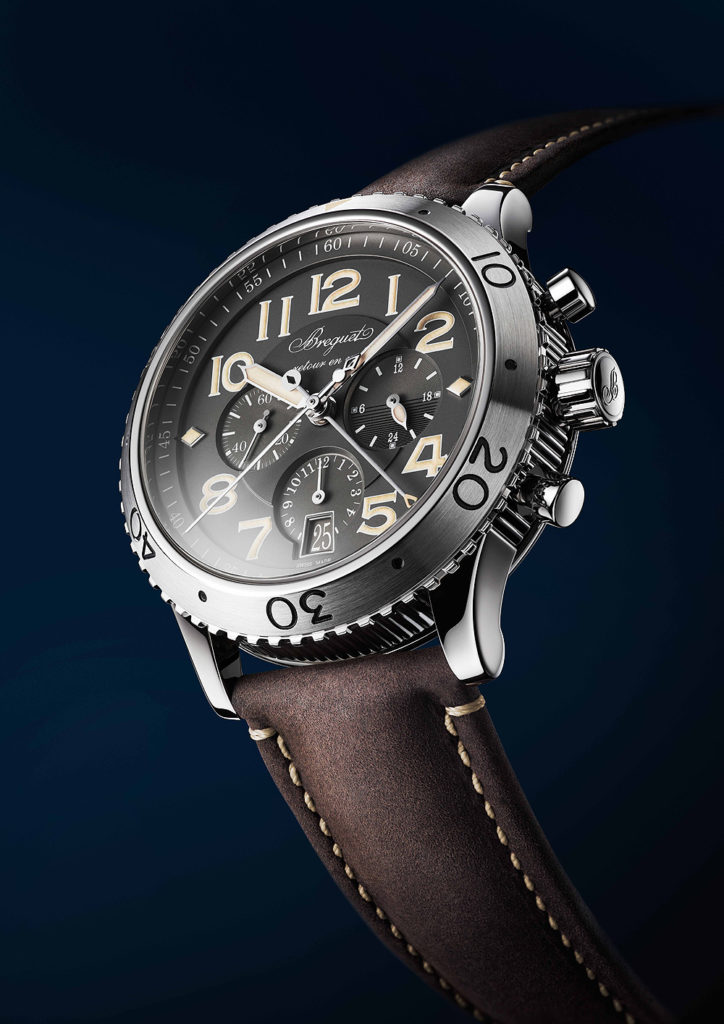
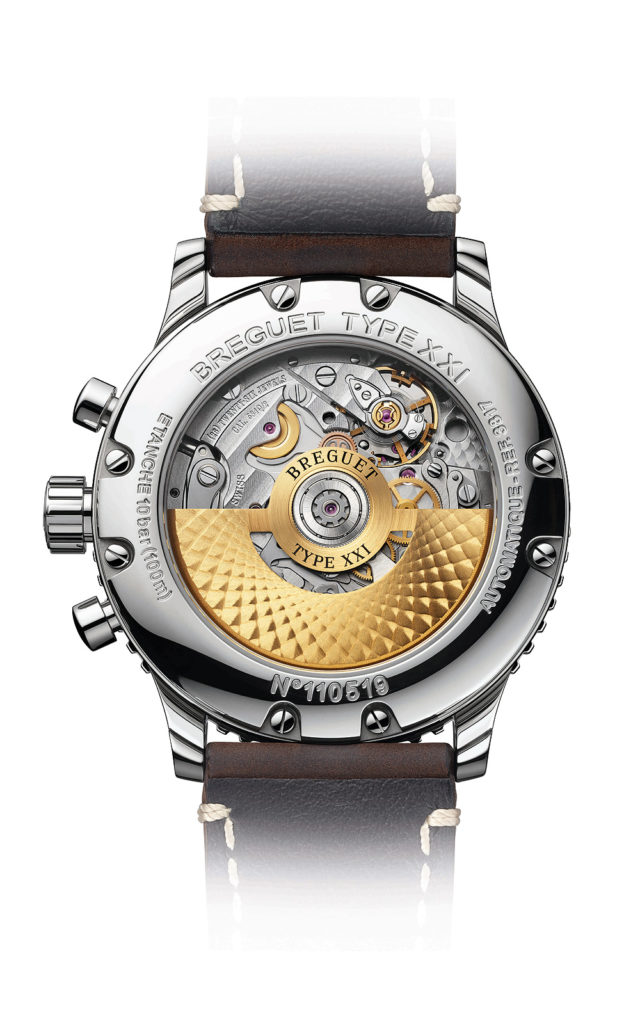
The Type XXI made a triumphant comeback in 2016 as the Type XXI 3817 Chronograph. Its self-winding, flyback-chronograph-equipped Caliber 584Q/2 is housed inside a 42-mm stainless-steel case and behind a retro-styled slate gray dial. The 584Q/2 caliber is a slight technical upgrade from the 584Q inside its titanium predecessor, adding more silicon components, including the silicon pallets in its inverted in-line Swiss lever escapement. The engraved bidirectional bezel has a smooth, brushed finish and the screw- down crown ensures a very contemporary 100-meter water resistance. Also contemporary is the addition of a sapphire window in the caseback through which to view the movement and its decorated gold rotor — a first for a Breguet aviation watch. The manufacture also embraces the Type XX’s vintage origins for the rugged, pilot-style strap made of brown calfskin leather with contrasting off-white stitching.
The collectability of vintage watches in general, and rare, vintage military models in particular, has never been stronger. And in 2019, Breguet finally returned to the military-commissioned Type 20 design that put its pilots’ watches on the map with a one-of-a-kind edition. For that year’s Only Watch auction — a biennial charity event that takes place in Monaco and raises funds for muscular dystrophy research by selling unique timepieces from a variety of watch brands — Breguet resurrected the Type 20 (note the return to Arabic numerals) in its original 38.3-mm stainless-steel case. The timepiece, which sold for an impressive 210,000 Swiss francs, also bore the two-register design, curved lugs and large onion-shaped crown of its ancestor, but also some contemporary elements derived from recent Type XX watches, such as the bronze-hued dial and Breguet signature at 12 o’clock; military-issue models rarely carried a brand name. Behind the engraved caseback that denotes its unique status, Breguet used a manual-winding, flyback-chronograph-equipped Valjoux 235 caliber, a modernized version of the movement used in the original timepiece.
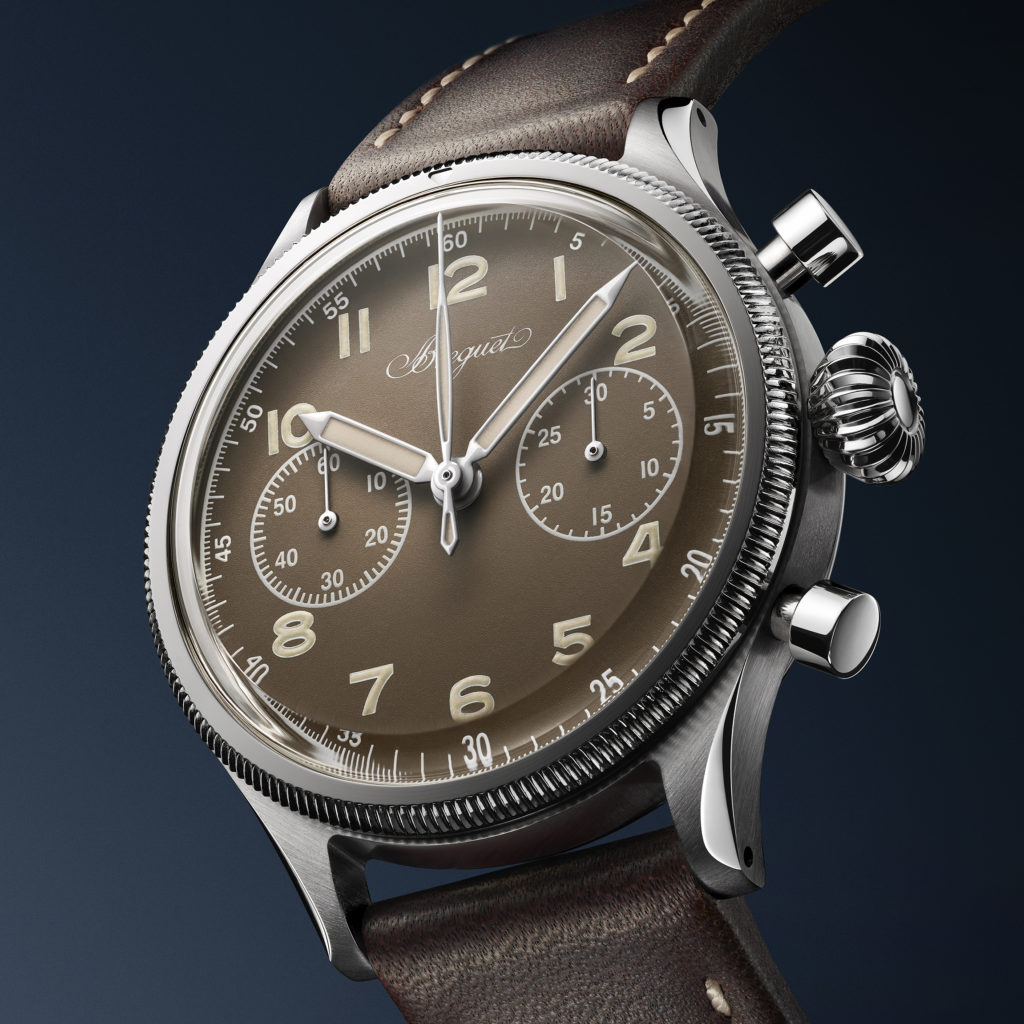
Like the legendary watch firm that preceded it, Breguet Aviation is no longer in the hands of the founding family. Louis Charles died in 1955, ending an extraordinary life of aeronautic accomplishments; his company merged with the French aircraft manufacturer Dassault in 1971, and was subsequently rebranded Dassault Aviation. Whether it’s wristwatches or airplanes, however, the impact of the Breguet dynasty is enduring and undeniable, and the Type XX collection is the purest and most sublime expression of its shared history.

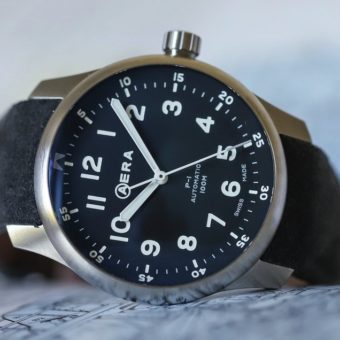
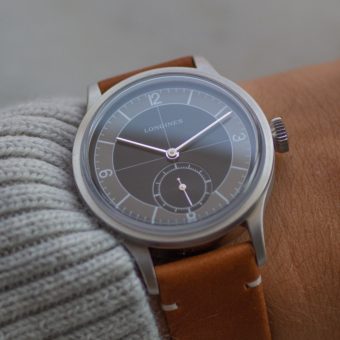


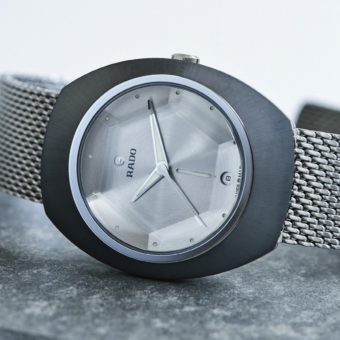
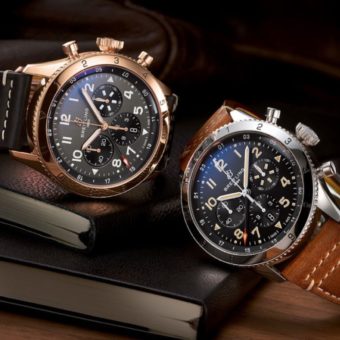
Great family history….
The 3807 type XX blue face Japan addition has an exhibition back. No gold rotor.
I have a pocket watch a Breguet